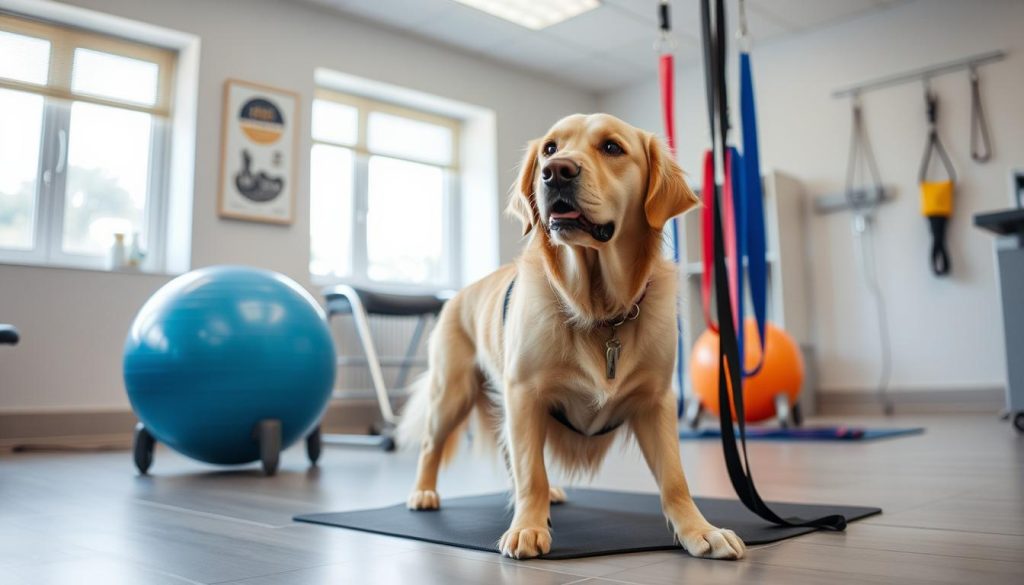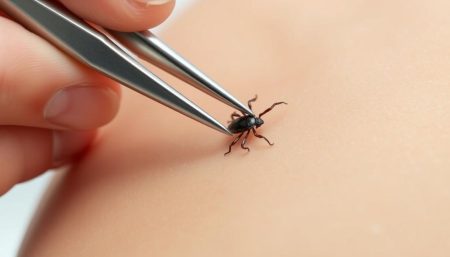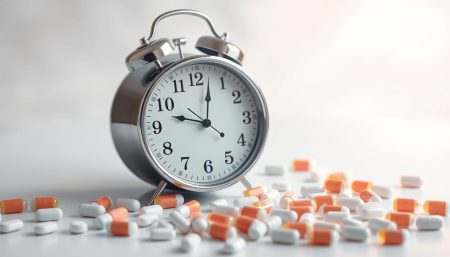Physical therapy is key for dogs recovering from knee surgery. It helps them regain strength and move better. Vets often suggest physical therapy for dogs after knee surgery to speed up healing and improve results.
Rehabilitation for dogs after surgery includes various techniques. These include controlled exercises, massage, and movement therapies. These methods aim to lessen pain, boost flexibility, and restore function. A customized program helps dogs get back to their usual activities quickly and safely.
The recovery from dog knee surgery needs patience and commitment. Owners are essential in this journey, working with vets. With the right care and regular therapy, many dogs do well and get back to their active lives.
Understanding Canine Knee Surgery and Recovery Basics
Dog knee surgeries are complex and need careful planning and recovery. Veterinarians do these surgeries to help dogs move better and live better lives. We’ll look at the common surgeries, how long recovery takes, and what signs of healing are normal.
Common Types of Dog Knee Surgeries
After surgery, dogs need to recover to move better. Surgeries like fixing the cruciate ligament and fixing patellar luxation are common. Treating dog ACL injuries is also common, using methods like TPLO or lateral suture stabilization.
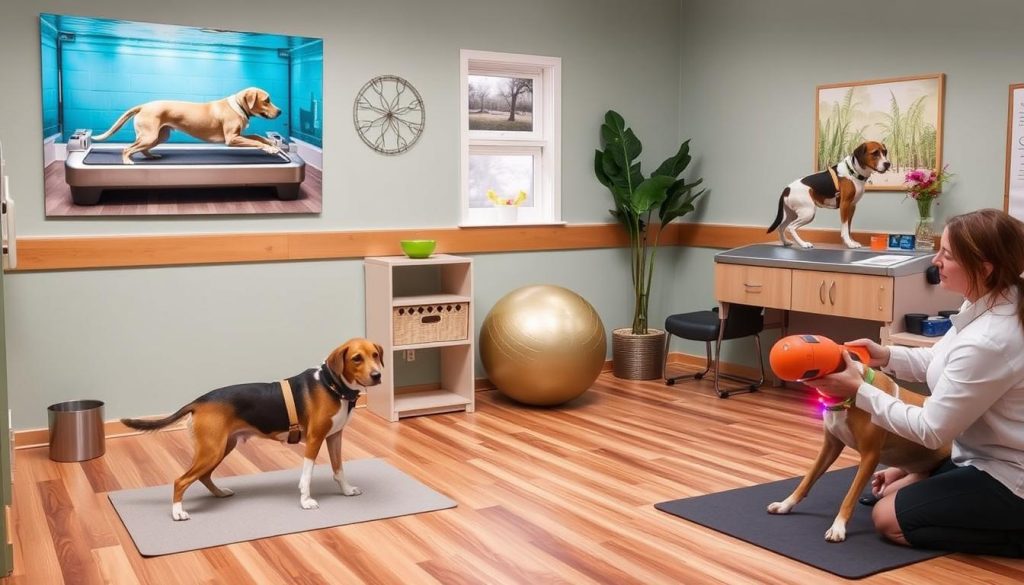
Initial Recovery Timeline Expectations
The recovery time after knee surgery varies. It usually takes 6-8 weeks. During this time, dogs need to rest and be closely watched. They start moving again slowly, with the vet’s help, to heal right.
Signs of Normal Healing Progress
Knowing when a dog is healing well is important. Look for these signs:
- Less swelling around the surgery area
- Being able to put more weight on the leg
- Moving the joint more easily
- Slowly getting back to normal activities
Watching for these signs and following the vet’s care plan is key. Regular vet visits and sticking to the recovery plan help dogs recover well from knee surgeries.
Physical Therapy for Dogs After Knee Surgery
Physical therapy is key for dogs after knee surgery. It helps them move better, feel less pain, and get back to their usual activities. Each dog gets exercises and treatments that fit their needs for cruciate ligament rehab.
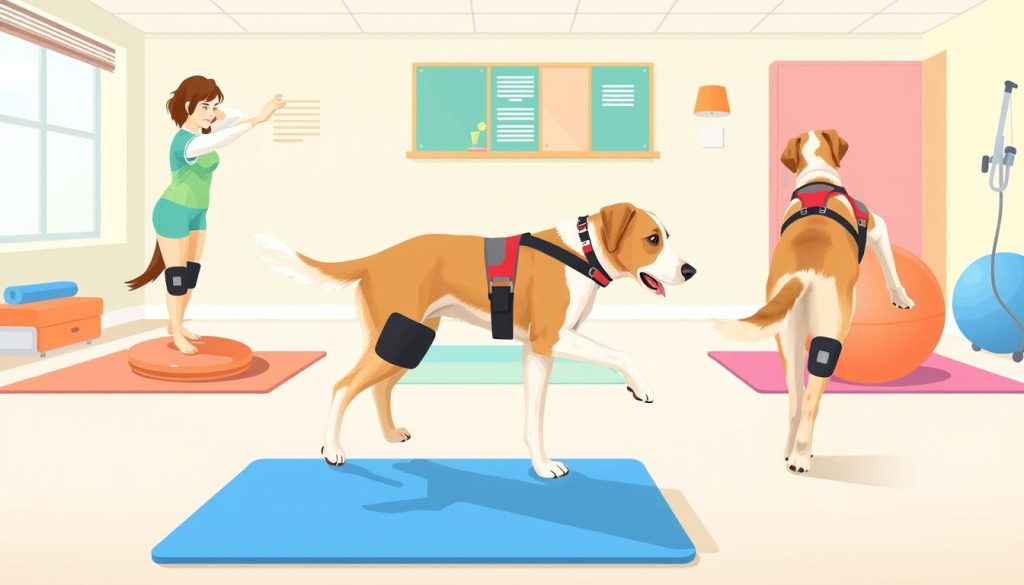
The therapy starts with easy exercises to loosen up joints. As they get better, dogs do more to build strength. These might include:
- Passive range of motion exercises
- Balance and proprioception training
- Controlled walking
- Underwater treadmill sessions
Managing pain is a big part of therapy. Therapists use massages, cold packs, and laser treatments to help dogs feel better and heal faster.
“Proper rehabilitation can significantly speed up recovery and reduce the risk of re-injury in dogs recovering from knee surgery.”
How long and intense the rehab is depends on the dog’s age, breed, and health. A typical plan might be:
| Week | Activities | Goals |
|---|---|---|
| 1-2 | Rest, ice therapy, passive range of motion | Reduce swelling, maintain joint mobility |
| 3-4 | Short leash walks, balance exercises | Improve weight-bearing, build strength |
| 5-8 | Longer walks, hydrotherapy | Increase endurance, enhance muscle tone |
| 9+ | Gradual return to normal activities | Full recovery, prevent future injuries |
With a good physical therapy plan, dogs can fully recover from knee surgery. They regain their mobility and enjoy life again.
Benefits of Post-Operative Rehabilitation for Dogs
Rehabilitation after a dog’s knee surgery is key to their recovery. It helps them get back their strength and mobility. Let’s look at the main advantages of physical therapy for dog knee injuries.
Improved Joint Mobility and Flexibility
Physical therapy for dog knee injuries aims to restore joint function. It uses gentle exercises and stretches to increase flexibility. This makes it easier for dogs to move comfortably and naturally.

Pain Management and Reduction
Physical therapy techniques help manage pain after surgery. Massage, heat therapy, and controlled movements reduce discomfort. These methods help the healing process and lower the need for pain meds.
Faster Return to Normal Activities
Proper rehabilitation speeds up recovery. Dogs getting physical therapy often get back to their usual activities faster. This includes walking, running, and playing without the fear of getting hurt again.
- Strengthens muscles supporting the knee
- Improves balance and coordination
- Reduces the risk of future injuries
Physical therapy for dog knee injuries offers many benefits. It improves mobility, manages pain, and speeds up recovery. With a customized rehabilitation program, dogs can quickly regain their quality of life safely.
Essential Equipment for Dog Knee Rehabilitation
Dog knee rehabilitation needs special tools for a good recovery. A dog knee brace is key for aftercare. It helps support and stabilize the injured joint, making it easier for your pet to move while healing.
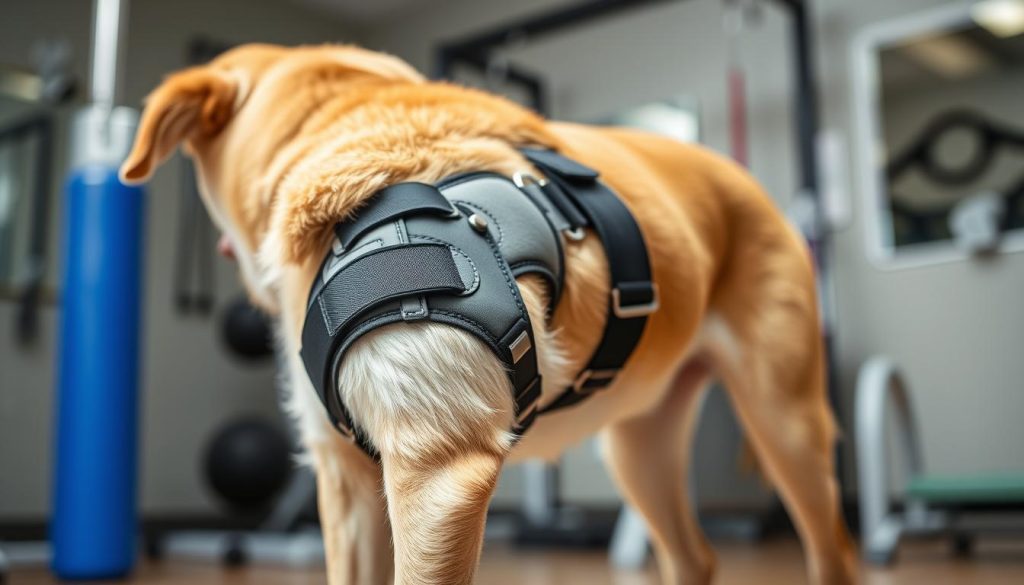
Balance boards and therapy balls are great for knee joint physiotherapy. They help improve your dog’s balance and coordination, strengthening the knee muscles. Resistance bands also help build muscle strength safely and gradually.
It’s important to make your home safe for rehabilitation. Use non-slip mats to prevent slipping. Ramps can help your dog avoid stairs, which is good for the healing knee. A comfy, supportive bed is also important for rest between therapy sessions.
- Dog knee brace
- Balance board
- Therapy ball
- Resistance bands
- Non-slip mats
- Ramps
- Supportive bed
Every dog’s recovery is different. Talk to your vet or a canine physical therapist to find the best equipment for your pet. With the right tools and advice, your dog can make great progress in their knee rehabilitation.
First Week Recovery: Initial Therapeutic Approaches
The first week after dog knee surgery is key for healing. Physical therapy starts with gentle steps to help recovery and avoid problems. Let’s look at the early rehab steps.
Controlled Rest and Movement
Rest is important, but too much can cause stiffness. Short, controlled walks on a leash are good. Start with 5-minute walks and increase as your vet advises. This keeps muscles toned and blood flowing without stressing the joint too much.

Ice Therapy Applications
Ice therapy is simple but effective for swelling and pain. Use an ice pack wrapped in a towel on the surgical area for 10-15 minutes, 3-4 times a day. It reduces inflammation and comforts your pet.
Passive Range of Motion Exercises
Gentle exercises for joint flexibility are vital. These exercises prevent muscle loss. Here’s a simple routine:
- Gently flex and extend the affected leg
- Hold each position for 3-5 seconds
- Repeat 10-15 times, 2-3 times daily
Do these exercises carefully, stopping if your dog is uncomfortable. Talk to your vet or a canine physical therapist for the right way and personalized tips.
| Activity | Frequency | Duration |
|---|---|---|
| Controlled Walks | 2-3 times daily | 5 minutes initially |
| Ice Therapy | 3-4 times daily | 10-15 minutes |
| Passive Range of Motion | 2-3 times daily | 10-15 repetitions |
Progressive Movement and Exercise Protocols
As your dog moves through knee rehab, changing exercise plans is key. The aim is to increase activity safely. Let’s look at how to boost your pet’s exercise routine.
Begin with light weight-bearing exercises. Have your dog stand on the affected leg for a bit. As they get stronger, increase the time. This helps build muscle and strengthen joints.
Then, start controlled walks. Begin with 5-minute walks on a leash. Over time, increase the walk’s length and distance. This keeps blood flowing and muscles from wasting away.
Balance exercises are important later on. Use wobble boards or cushions to test your dog’s balance. This improves their coordination and helps avoid future injuries.
| Recovery Stage | Exercise Type | Duration | Frequency |
|---|---|---|---|
| Early | Passive range of motion | 5-10 minutes | 2-3 times daily |
| Intermediate | Controlled leash walks | 10-15 minutes | 2 times daily |
| Advanced | Balance and strength training | 15-20 minutes | Once daily |
Every dog recovers differently. Always check with your vet before trying new exercises. With patience and regular effort, your dog will soon be running around again.
Underwater Treadmill Therapy and Hydrotherapy Benefits
Underwater treadmill therapy and hydrotherapy are great for treating dog ACL injuries. They are safe and effective ways to help dogs recover after knee surgery.
Water Resistance Training
Water resistance training helps dogs get stronger without hurting their joints. The water supports their weight, easing the pressure on their knees. This lets dogs start moving and exercising sooner during their recovery.
Low-Impact Exercise Benefits
Aquatic therapy is low-impact, which is easy on joints. Dogs can move more easily in water, improving their range of motion without pain. It’s perfect for dogs recovering from surgery and helps prevent muscle loss.
Muscle Strengthening Techniques
Underwater treadmills let therapists adjust the water level and speed. This customizes the workout for each dog, helping to build muscle strength. Water-based exercises can target specific muscles to support the healing knee joint.
| Benefit | Impact on Recovery |
|---|---|
| Reduced joint stress | Allows earlier rehabilitation |
| Improved circulation | Speeds healing process |
| Increased range of motion | Restores normal joint function |
| Controlled resistance | Builds muscle strength safely |
Manual Therapy Techniques for Canine Recovery
Manual therapy is key in helping dogs recover from knee surgery. It makes moving easier and less painful. Veterinarians use different methods to help your dog get better.
Massage is a big part of physical therapy for dogs after surgery. It boosts blood flow, relaxes muscles, and eases pain. Soft strokes on the leg can calm your dog and help them heal faster.
Joint mobilization helps the knee move better. A skilled therapist uses gentle pressure to move the joint. This helps break down scar tissue and improves function.
Stretching keeps muscles long and prevents stiffness. Your vet will show you how to stretch safely at home. Stretch slowly and gently to avoid hurting your dog.
- Massage: Promotes circulation and relaxation
- Joint mobilization: Improves flexibility and range of motion
- Stretching: Maintains muscle length and prevents stiffness
Always talk to your vet before trying manual therapy at home. They can tell you how to do it right and how often. This keeps your dog safe during recovery.
Home Exercise Program Guidelines
A good home exercise program is key for your dog’s recovery after knee surgery. This guide will show you how to create a safe space and set up effective routines for your dog’s rehab.
Safe Exercise Environment Setup
Make a non-slip area for your dog’s exercises. Use rubber mats or carpets for grip. Make sure the area is clear of obstacles and big enough for your pet to move around.
Daily Exercise Routines
Include these exercises in your dog’s daily routine:
- Gentle leg stretches
- Slow walks on a leash
- Controlled sit-to-stand repetitions
- Balance exercises on a cushion
Begin with 5-10 minutes of activity. Gradually increase the time as your dog gets stronger. Always check with your vet for the best physical therapy plan.
Monitoring Progress at Home
Keep a daily log of your dog’s exercises and any changes in their mobility or comfort. Use a pain score chart to track their recovery:
| Pain Score | Description | Action |
|---|---|---|
| 0-2 | Minimal discomfort | Continue exercises as planned |
| 3-5 | Moderate pain | Reduce exercise intensity |
| 6-10 | Severe pain | Contact your vet immediately |
By following these guidelines and doing dog knee surgery exercises regularly, you’ll help your pet recover and regain strength and mobility.
Pain Management and Therapeutic Modalities
Pain management is key in caring for dogs with knee injuries after surgery. Veterinarians use many ways to keep dogs comfortable during their recovery. They mix medicines and non-medical methods to help the dog heal and feel better.
Medicines are a big part of controlling pain. Vets give dogs special drugs to help with pain and swelling. These medicines let dogs do exercises better during their recovery.
Cold therapy is another way to manage pain without medicine. Using ice packs on the knee area helps reduce swelling and pain. It’s very helpful in the early stages of getting better.
Therapeutic ultrasound is also important in dog knee recovery. It uses sound waves to make tissues warm, which helps blood flow and healing. It also helps move scar tissue, making joints more flexible.
Vets often use a mix of these methods for the best results. This way, dogs stay comfortable and recover better. It makes the whole process smoother and more effective.
Measuring Recovery Progress and Milestones
It’s key to track your dog’s knee surgery recovery to ensure they heal well. Physical therapy for dogs after knee surgery includes regular checks to see how they’re doing. Let’s look at ways to measure and document your dog’s journey to health.
Physical Assessment Methods
Vets use different methods to check on your dog’s recovery. They might use goniometry to measure joint angles and check muscle size. Regular visits help vets see how your dog is doing and change treatment plans if needed.
Functional Testing Guidelines
Functional tests show if a dog is ready to do normal things again. These tests might include:
- Walking tests to check how well they move and bear weight
- Sit-to-stand exercises to see how strong they are
- Controlled jumping exercises for when they’re more advanced
Progress Documentation Tips
It’s important to keep detailed records of your dog’s recovery. Use this table to track their progress:
| Week | Pain Level (1-10) | Mobility (Poor/Fair/Good) | Daily Exercise Time |
|---|---|---|---|
| 1 | 8 | Poor | 5 minutes |
| 2 | 6 | Fair | 10 minutes |
| 4 | 4 | Good | 20 minutes |
By regularly checking these things, you’ll get a good idea of how your dog is doing. Remember, every dog heals at their own pace. So, be patient and always follow your vet’s advice during the recovery.
Long-term Management and Prevention Strategies
After knee surgery, dogs need ongoing care to stay healthy. Regular exercise keeps their joints flexible and muscles strong. A vet can suggest safe activities for your pet.
Walking, swimming, and gentle play are often good choices. These activities help with canine cruciate ligament rehabilitation and prevent future injuries.
Keeping your dog at a healthy weight is also important. Extra pounds can stress their knees and other joints. Feed your pet a balanced diet and control portions.
Some dogs may benefit from special joint-supporting foods or supplements. Ask your vet for advice on the best nutrition plan for your furry friend.
In some cases, dog knee brace aftercare can provide extra support during activities. These braces help stabilize the joint and reduce strain. They’re useful for active dogs or those prone to knee problems.
Your vet or physical therapist can show you how to use a brace correctly.
Remember, prevention is key. Regular check-ups, proper exercise, and good nutrition can help avoid future knee issues. By following these long-term strategies, you’ll give your dog the best chance at a happy, active life after knee surgery.
FAQ
Q: How long does physical therapy typically last for dogs after knee surgery?
A: Physical therapy for dogs after knee surgery can last from 8 to 12 weeks. Sometimes, it can go up to 6 months. It’s important to follow your vet’s advice and keep up with therapy until your dog fully recovers.
Q: What are the most common types of knee surgeries performed on dogs?
A: Dogs often get knee surgeries for cruciate ligament repair, patellar luxation correction, and meniscus repair. Cruciate ligament repairs are very common because these injuries are common in dogs.
Q: How soon after surgery can a dog start physical therapy?
A: Physical therapy for dogs starts right after surgery, even in the hospital. At first, it includes passive exercises and rest. As they get better, more active therapy is added by a vet.
Q: What are the benefits of underwater treadmill therapy for dogs recovering from knee surgery?
A: Underwater treadmill therapy is great for dogs after knee surgery. It’s low-impact, strengthens muscles, improves circulation, and reduces pain and swelling. It also helps with balance and supports the dog’s weight.
Q: Can I perform physical therapy exercises at home with my dog?
A: Yes, you can do some exercises at home with your dog. Your vet can teach you controlled walks, passive exercises, and balance activities. But, always get proper instructions first.
Q: How often should I apply ice therapy to my dog’s knee after surgery?
A: Use ice therapy for the first 72 hours after surgery. Wrap ice packs in a towel and apply for 15-20 minutes, 3-4 times a day. After that, your vet might suggest ice and heat alternation. Always follow their advice, as needs can vary.
Q: What signs indicate that my dog’s knee is healing properly after surgery?
A: Signs of healing include better weight-bearing, more joint movement, less swelling, and normal daily activities. Your dog should also seem more comfortable and willing to do exercises. Regular vet visits confirm healing progress.
Q: Are there any specific breeds more prone to knee injuries in dogs?
A: Yes, some breeds are more likely to get knee injuries. Large breeds like Labradors and Rottweilers often get cruciate ligament injuries. Small breeds like Pomeranians are more likely to have patellar luxation. But, any breed can get knee injuries, and factors like weight and activity level also matter.
Q: How can I prevent future knee injuries in my dog?
A: To prevent knee injuries, keep your dog at a healthy weight and provide regular, low-impact exercise. Avoid activities that strain the knees too much. Use braces for high-impact activities. Regular vet visits can also help catch issues early.
Q: What role does nutrition play in a dog’s recovery from knee surgery?
A: Good nutrition is key for healing after knee surgery. A balanced diet with protein helps repair tissues and maintain muscles. Omega-3 fatty acids reduce inflammation, and supplements like glucosamine and chondroitin support joints. Always talk to your vet before changing your dog’s diet or adding supplements.












